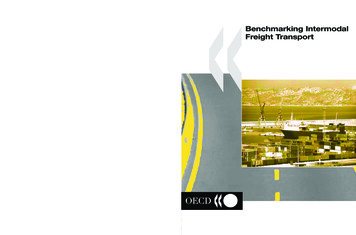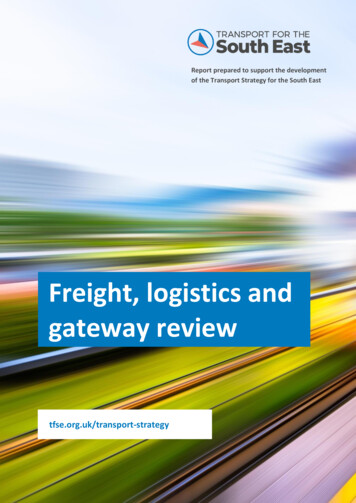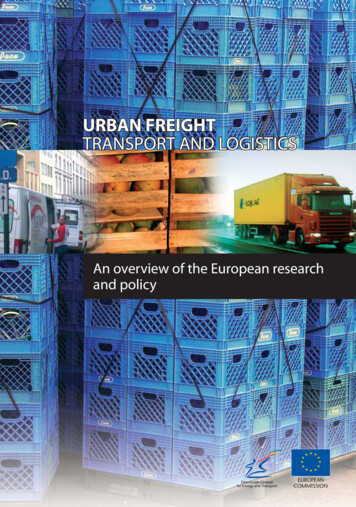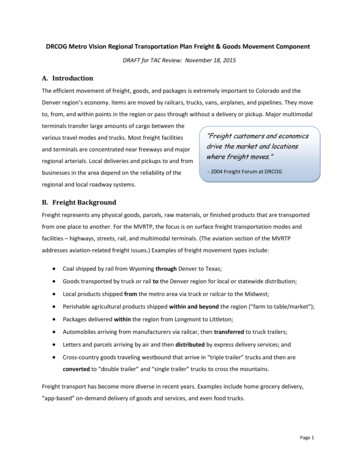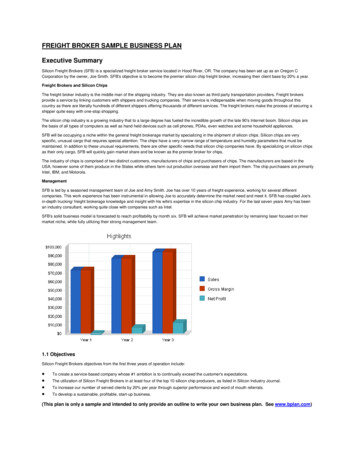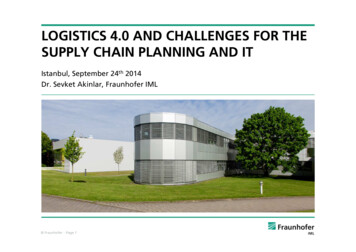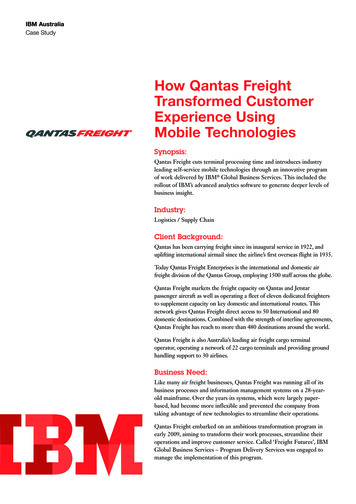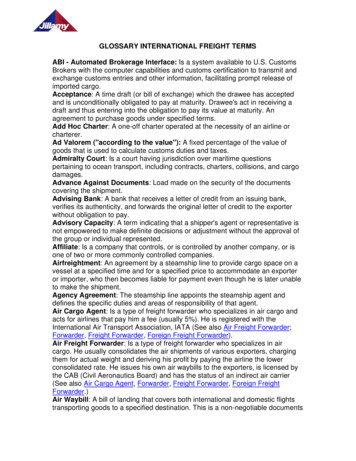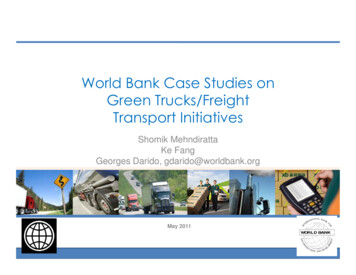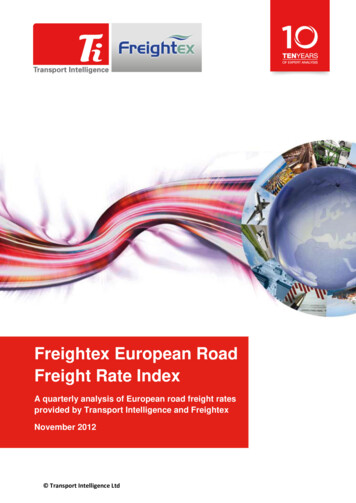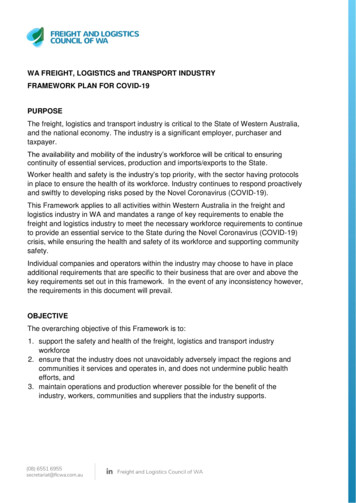
Transcription
WA FREIGHT, LOGISTICS and TRANSPORT INDUSTRYFRAMEWORK PLAN FOR COVID-19PURPOSEThe freight, logistics and transport industry is critical to the State of Western Australia,and the national economy. The industry is a significant employer, purchaser andtaxpayer.The availability and mobility of the industry’s workforce will be critical to ensuringcontinuity of essential services, production and imports/exports to the State.Worker health and safety is the industry’s top priority, with the sector having protocolsin place to ensure the health of its workforce. Industry continues to respond proactivelyand swiftly to developing risks posed by the Novel Coronavirus (COVID-19).This Framework applies to all activities within Western Australia in the freight andlogistics industry in WA and mandates a range of key requirements to enable thefreight and logistics industry to meet the necessary workforce requirements to continueto provide an essential service to the State during the Novel Coronavirus (COVID-19)crisis, while ensuring the health and safety of its workforce and supporting communitysafety.Individual companies and operators within the industry may choose to have in placeadditional requirements that are specific to their business that are over and above thekey requirements set out in this framework. In the event of any inconsistency however,the requirements in this document will prevail.OBJECTIVEThe overarching objective of this Framework is to:1. support the safety and health of the freight, logistics and transport industryworkforce2. ensure that the industry does not unavoidably adversely impact the regions andcommunities it services and operates in, and does not undermine public healthefforts, and3. maintain operations and production wherever possible for the benefit of theindustry, workers, communities and suppliers that the industry supports.
The Framework has been developed by the Freight and Logistics Council of WesternAustralia and key representatives from the industry to ensure a consistent andproactive approach in the freight, logistics and transport sector in the State.The Framework is intended to reinforce and operate concurrently with the public healtharrangements as they are put in place from time to time by the Government to manageand address the impacts of COVID-19. For the avoidance of doubt, this includesrestrictions on Federal or State borders, or the movement of people.KEY REQUIREMENTSThe Framework establishes the key requirements that the freight and logistics sectorswill have in place in consultation with the Government.The freight and logistics sectors commit to have in place detailed policies andprocedures to deliver on the intent and objectives of the Framework.To reiterate, the Framework operates in the context of any public health restrictions andthe industry supports the broader implementation of those arrangements for thecommunity.Workers health and safety is paramount, and the industry will ensure workers areprotected from undue exposure to COVID-19 and have in place the health protocolsand services to be able to respond if a worker is infected.The Framework specifies key requirements to be included in the freight and logisticssectors approach in order to operate while any restrictions are in place.These include:Supporting the industry’s workersa. (Information for workers) Freight and logistics companies will provide regular andconsistent updates to workers on the spread of COVID-19 in their communities,strategies to avoid contracting it both in and outside the workplace (eg socialdistancing/sanitation etc), ways to support colleagues and their families, and therequirements contained within this Framework.
b. (Mental Health) Freight and logistics companies and industry representativesacknowledge that this is a difficult and stressful time for the industry’s workforce. Thesector is already proactive in addressing mental health and wellbeing and thereforewell placed to support workers at this time. Companies continue to ramp-up the widevariety of supports in place to support the mental health and wellbeing of theiremployees.c. (Equipment) Freight and logistics companies will ensure so far as is possible thatworkers have access to all the necessary health and safety equipment to preventthe spread of the disease (e.g. sanitisers, soap etc.) and protect themselves fromcontracting it.d. (Point of contact). Each freight and logistics company will nominate a key contactfor their workers to get more information about the respective company’s effortsunder the Framework.Prevent and protect workplaces from infectione. (Symptoms testing) Freight and logistics companies will incorporate a symptomsidentification process to identify early warnings and presentations (eg: temperaturetesting/self-reporting etc).f. (Government rules) Industry will take best steps to enforce the government’s rulesamongst their workforces (e.g. that any worker who has been overseas or been incontact with someone with COVID-19 will be in self-isolation for 14 days)g. (Sanitation) High sanitation is practised at freight and logistics locations howeveradditional cleaning protocols will be put in place for all common areas and equipment.At any point, the Government can query, inspect premises and makerecommendations with respect to sanitation at a site.h. (Distancing) Operators will implement procedures and processes to ensure physicaland social distancing is practised through individual or group segregation, consistentwith Government advice. Workers will be provided with information on how toimplement physical or social distancing.i.(Group events) Group events like meals and start-ups are being cancelled orstaggered and held outdoors/larger facilities to significantly reduce people numbersin one place and comply with social distancing requirements.
j.(Health professional support) Each operator will have a procedure in place tomanage the initial stages of situations where a suspected COVID-19 case presents.Responding to positive tests and evacuationk. (Quarantine) Where a positive test is returned, or a case is suspected, the individualwill be documented on a register and sent home to self-isolate.l.(COVID-19 Action Plan) Every freight and logistics company will have a specificaction plan in place for response to COVID-19 cases (eg: standing down/isolation ofworkers, cleaning of workplaces etc).m. (Effective communication) - Freight and logistics companies will communicate withother parties in relation to any suspected COVID-19 cases where there is a possibilityof contact across companies.n. (Risk assessment and mitigation). Freight and logistics companies will compile alist of workers that fit into highest risk categories as identified by the Chief HealthOfficer or their delegate (eg: older workers and those with underlying health issues)and ensure there are appropriate mechanisms in place to prevent and respond to aninfection.o. (Evacuation – mild or medium) Freight and logistics operators will have in plans inplace as part of their COVID-19 Action Plan for mild or medium presentations. Thesecould include, for example, evacuation of a driver with symptoms presenting duringa trip and the segregation and stand-down of exposed crews.Public health and managing community interactionsp. (Minimise impact on communities) To reflect the freight and logistics company’scommitment to minimise their impact on the regional and remote communities wherethey operate, companies will seek to put in place arrangements to minimise allinteraction between their activities and communities.
Monitoring and Reportingq. (Reporting) Through the industry representative, the industry is committed to providedaily reports to the Government of any new COVID-19 cases, evacuations,recoveries and current caseload.r. (Government validation) The Framework is submitted to the Government for theirinput and advice and ultimately validation. The Framework can be refined as neededby the Government (and specifically the Chief Health Officer or their delegate).s. (Contact person) The industry nominates the Freight & Logistics Council of WA astheir representative to act as the central point of contact for this Framework with theGovernment.Travel & work protocolst. (Transit protocols) Subject to government requirements the freight and logisticssector operators will be allowed to continue operations & production inclusive ofintrastate and interstate movements (based on strict guidelines and protocols). All such workers will be restricted to operational critical personnel only All such personnel from interstate must go through stringent pre-start checksbefore commencing work. Industry representatives will work with freight and logistics companies toundertake a ‘needs analysis’ and, if necessary, to adjust shift rosters toensure minimum number such personnel are moving around or entering thestate.u. (Temporary relocation) Freight and logistics companies may offerinterstate/intrastate critical personnel the option of being based in WA or specificregion during this period.
MODAL SPECIFIC REQUIREMENTSIn addition to the general requirements stipulated in this Framework for the entireindustry, the below modal specific requirements will also be enforced.Ports and Shippinga. (Distancing) Operators will implement procedures and processes to ensure physicaland social distancing is practised with all vessel crew at all times. Workers will beprovided with information on how to implement physical or social distancing.b. (Quarantine) Where a confirmed or suspected case of COVID-19 is present on avessel it will not be permitted to load/unload.c. (Port Authority Measures). Operators will comply with all requirements stipulatedby the Australian Border Force and relevant Port Authorities.Raila. (Sanitation) Additional cleaning protocols will be implemented by rail operators toensure locomotives and associated devices are cleaned with increased frequency.b. (Essential Services) Operators will focus on maintaining essential goods andpower supply.Roada. (Distancing) Operators will implement procedures and processes to ensure physicaland social distancing is practised at all delivery and pick-up locations. Workers willbe provided with information on how to implement physical or social distancing.GOVERNANCE & IMPLEMENTATIONThe Framework is intended to guide the actions of freight and logistics companies. ThisFramework can be reviewed, escalated or strengthened based on advice by theGovernment and specifically the Chief Health Officer or their delegate.With reasonable notice, the freight and logistics sector are committed to cooperatingwith and implementing the Government’s guidance.
For the avoidance of doubt, this Framework seeks to apply a risk-based approachbased on scientific evidence currently available and follow applicable local andinternational health authority guidance to enable the continued operation andproduction of a state and nationally significant industry.
ADDENDUMNational Protocol for Domestic Border Controls – Freight MovementsKey components for the freight industryManaging risks to the health and wellbeing of freight workers COVID-19 tests should be available at no cost to heavy vehicle drivers and rail crewwhether or not symptoms are present if required by this protocol. Heavy vehicledrivers and rail crew should continue to observe their requirements under relevantheavy vehicle or rail regulations respectively, in particular fatigue requirements. The National Cabinet decision in relation to rest stops, will continue to apply and canbe accessed at: www.infrastructure.gov.au/vehicles/vehicle st-stop-facilities.pdf Assistance on how to locate a heavy vehicle rest place can be found at:www.nhvr.gov.au/road-access/route-planner Arrangements should be made to allow heavy vehicle drivers to change over at, orclose to, a state border to enable drivers to stay within a state where practical. Thisshould be facilitated by utilising rest stop facilities where possible.Managing risks of community transmissions from workers moving across state borders Any heavy vehicle driver or rail crew with any COVID-19 symptom present, shouldseek immediate COVID-19 testing and medical advice. Routine COVID-19 testing of heavy vehicle drivers or rail crew should be required fordrivers that are planning on entering or leaving hot spots, or if directed by medical orhealth agency advice. To assist with contact tracing, heavy vehicle drivers and rail crew who cross bordersand/or enter or leave hotspots, should be required to keep a record of all closecontacts. A close contact is a face-to-face contact for 15 minutes or more, or a personsharing an enclosed space for over 2 hours.o A common national form for records will be developed, to be lodged with workdiary records. Heavy vehicle drivers and rail crew should be required to have minimal or no closeperson to person contact at any border check locations, truck rest stops androadhouses, and any accommodation facilities used on a journey, where practical.
In addition to the COVIDSafe workplans that freight companies have in place, thefollowing protocols will also apply to reduce the risk of COVID-19 transmission.Heavy vehicle drivers, support workers and rail crew must observe the following: No passengers will be allowed to travel in trucks or trains unless they are freightworkers, for example authorised two up teams. Only exit the vehicle to access rest stop facilities, refuelling, accommodation,activities directly related to the delivery or loading of freight or to meet requiredregulated activities, e.g. work health and safety or fatigue management. Follow all COVID-19 related instructions from employees at any premises accessed. Employ or introduce non-contact receipt and collection processes for freight whenpossible. Wash or sanitise hands at all appropriate times, but especially at entry to a premises,and prior to leaving. Maintain appropriate social distancing while in any premises. During freight journeys, drivers should avoid large venues/restaurants and useroadhouse facilities wherever possible. Overnight stays at accommodation should occur only when necessary to fulfil fatiguerequirements. Accommodation providers must apply COVIDSafe protocols andcleaning procedures to minimise risk. Truck drivers are not permitted to use commonareas in accommodation premises and will adhere to physical distancing and limitcontacts. PPE (such as gloves, eye protection and face masks) should be used wheneverphysical distancing is not possible, where directed by state or territory government, theDepartment of Health or Safe Work Australia, or when indicated by COVIDSafeworkplans. If displaying symptoms of illness such as a fever, cough or sore throat do not enter apremise, advise your employer, seek medical assistance, self-isolate until you seekmedical assistance and do not continue your journey.
SPECIFIC ADDITIONAL REQUIREMENTS FOR TRAVELLING THROUGHHOTSPOTSThe following applies to heavy vehicle drivers, support workers and rail crew Adhere to strict physical distancing and undertake additional precautions whenoperating in areas experiencing increased COVID-19 cases. Restrict stops to dedicated rest stops and roadhouse facilities. Transit through hotspots without stopping overnight unless required to meet requiredregulated activities, e.g. work health and safety or fatigue management. In the 14 days following entering or transiting a hotspot or until their next shift, limitactivities to restrict interactions with the public and broader family and friends,preferably by staying at their place of residence or appropriate venue where possible.However, this restriction will not apply if the vehicle has not stopped during transitthrough a hotspot. Should wear appropriate PPE when providing services in hotspot locations. Facemasks should be used in accordance with advice provided by the relevant jurisdiction,the Department of Health and Safe Work Australia.Advice from the Department of Health on avoiding infection, including guidance onhand hygiene, cough etiquette and social distancing is available othersFor general information concerning the Novel Coronavirus (COVID-19) please refer tothe Department of Health website: 019-ncov)For information on work health and safety requirements please refer to the Save WorkAustralia website: workplaces
New directions for transport and logistics workersThese new requirements override all previous directions for transport and logisticsworkers.Freight workers: At the border you will be checked for proof of testing within the previous 7 days you will need to provide a slip from a testing facility that shows your name and dateyou attended. (you do not need to provide results).If you cross the border and you don’t have proof of a test, then you will need to betested within 48 hours, you do not need to isolate whilst waiting for the results.If you do receive a positive test result you must call the number listed in thedirection and talk to a health officer, they will assist in finding a quarantine facilityand identifying appropriate arrangements for your vehicle and freight load.If you receive a positive result and are travelling with a co-driver they must also callthe number listed in the direction and talk to a health officer who will be able toassist.Whilst on route you must follow all the regular protocols (eg sanitising, physicaldistancing etc)To assist with contact tracing, drivers must complete a record of all close contactswhich must be available on request. A close contact is a face-to-face contact for 15minutes or more, or a person sharing an enclosed space for over 2 hours.Passengers – you can only travel with other exempt workers (eg two-up)In order to determine the 7-day period - day one starts at midnight on the dayyou have the test.Freight companies: must have in place appropriate protocols and procedures to assist workers.need to have plans in place to assist drivers including procedures to arrange forcleaning the cab, replacement driver and assisting in the coordination of quarantinerequirements.are responsible for ensuring that the test results of their workers remain negativethroughout the testing period.
c. (Equipment) Freight and logistics companies will ensure so far as is possible that workers have access to all the necessary health and safety equipment to prevent the spread of the disease (e.g. sanitisers, soap etc.) and protect themselves from contracting it. d. (Point of contact). Each freight and logistics company will nominate a key contact
